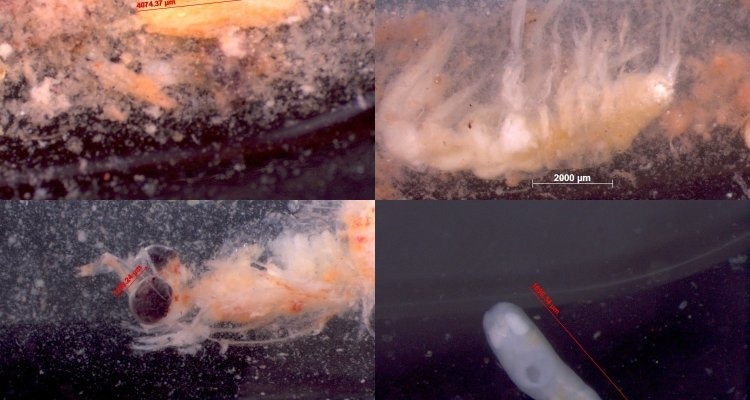An essential component of the Arctic food chain is polar fish. Along with colleagues from KU Leuven and the Alfred Wegener Institute, Sarah Maes (KU Leuven) and Fokje Schaafsma (Wageningen Marine Research) examined the diet of polar cod from the Barents Sea.
 Food items from the stomachs of polar cod. Top left: a copepod. Top right: remains of an amphipod. Bottom left: krill remains. Bottom right: this worm is not prey but a parasite, which are often found in fish stomachs. Image Credit: Fokje Schaafsma
Food items from the stomachs of polar cod. Top left: a copepod. Top right: remains of an amphipod. Bottom left: krill remains. Bottom right: this worm is not prey but a parasite, which are often found in fish stomachs. Image Credit: Fokje Schaafsma
They achieved this by integrating DNA analysis with conventional microscopy. The scientific journal Marine Ecology Progress Series has now published new findings from the study about the diet of Arctic cod.
When the investigated animal is small, a microscope is typically used to open the stomach and examine what is inside. Researchers are able to determine which prey was eaten and how much of it. Since some prey species are easier to digest than others, there may be a bias in how important some prey species are.
Some prey species might even be completely ignored. To solve this issue, Sarah Maes of the KU Leuven started an inquiry into the diet of polar cod using DNA analysis. This technique, together with conventional microscopic analysis, might be used to compare the outcomes of the two alternative approaches.
Investigating the diet using DNA analysis
Utilizing so-called DNA metabarcoding, the stomach contents that had been microscopically examined were further examined. The “read” DNA from the stomach is then compared to a database of DNA sequences from other animals worldwide. This makes the prey creatures that have been living in the Arctic cods’ guts identifiable.
The investigation revealed that many Arctic cod also consumed other fish species, most likely easy-to-digest eggs or larvae, in addition to their usual crustacean food.
This shows that, contrary to what was previously believed, fish are significantly more common prey. Barnacles were another unexpected prey species. The larvae of these species float in the water, despite the fact that they are typically best known for adhering to rocks or ships.
Added value of combining methods
An extensive range of prey species, including those that are simple to digest, was revealed through DNA research. Additionally, it assisted in the species-level identification of prey that is only partially visible by microscopy due to digestion.
Furthermore, prey species whose DNA is often detectable under a microscope but could not be observed at this time were present. Therefore, such prey had already been totally digested.
This demonstrates that, in contrast to microscopic examination, which only provides a snapshot of the food, DNA analysis provides information about it over a longer period of time.
Thus, combining the two approaches might provide insight into recent dietary changes. DNA analysis is unable to reveal specific information, such as the quantity of a particular prey in the stomach or the stage of development of a prey species.
However, such information is available via a microscopic examination of the stomach's contents. Therefore, combining the two approaches is helpful to learn more about how the food web functions and how important a species is to diet.
Importance of the research
Global warming is causing the Arctic to change quickly. Numerous studies have already demonstrated that many species’ oceanic distributional ranges are shifting northward. Dietary studies enable tracking changes in prey species and provide information on the condition of the Arctic food web.
In this manner, the Arctic cod’s capacity to adapt to climate change can be studied. For the purpose of creating policies involving fisheries or the preservation of nature, this information could also be used. The study also demonstrates which data can be obtained using different approaches and how these approaches can be combined.
Source:
Journal reference:
Maes, S. M., et al. (2022). Comparative visual and DNA-based diet assessment extends the prey spectrum of polar cod Boreogadus saida. Marine Ecology Progress Series. doi.org/10.3354/meps14145